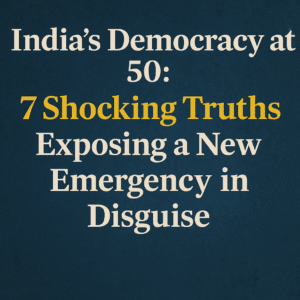India’s Democracy at 50: 7 Shocking Truths Exposing a New Emergency in Disguise
Fifty years after India’s 1975 Emergency, the anniversary has sparked bitter political battles. While the ruling BJP condemns that historical period and declares a “Constitution Murder Day,” the opposition accuses the current government of imposing a far worse “neo-Emergency.” Author M.G. Devasahayam, an eyewitness to the original Emergency, argues India’s democracy now faces a deeper crisis marked by the erosion of constitutional ideals—justice, liberty, equity, and fraternity—and the systematic weakening of institutions under a pervasive “governance by fear.”
A critical leadership vacuum exists, where genuine potential is stifled by sycophancy and suppression across parties, government, and academia. Despite this “deep-dark period,” the author detects a desperate public yearning for change and hopes courageous individuals will emerge to rejuvenate democracy, fulfilling the legacy of figures like Jayaprakash Narayan whose moral authority once restored freedom. The real tribute lies not in commemorating the past, but in confronting the present corrosion of India’s democratic soul.

India’s Democracy at 50: 7 Shocking Truths Exposing a New Emergency in Disguise
Fifty years after President Fakhruddin Ali Ahmed signed the proclamation plunging India into the “darkest period” of the 1975 Emergency, the anniversary has ignited fierce political combat, revealing less about the past and more about the precarious state of India’s democracy today. As BJP leaders, including Prime Minister Modi, vehemently condemned the Congress-imposed Emergency, declaring June 25th as “Samvidhaan Hatya Diwas” (Murder of Constitution Day), the opposition INDIA bloc countered with accusations of a far more insidious “neo-Emergency” strangling democratic institutions under the current regime.
A Ringside View & the Battle of Narratives:
M.G. Devasahayam, who witnessed the 1975 Emergency firsthand as the District Magistrate responsible for the custody of the movement’s moral leader, Jayaprakash Narayan (JP), offers a unique perspective. He observes the ruling BJP’s aggressive commemoration not merely as historical remembrance, but as a “flagrant act of theft” – appropriating the legacy of a people’s movement against authoritarianism while, critics argue, perpetuating an undeclared emergency themselves. The Congress, conversely, deflects by urging focus away from the past towards the present “strangulation and evisceration of institutions.”
The Uncomfortable Parallels:
Devasahayam posits a stark reality: India’s democracy has swung between extremes in these fifty years. From the overt tyranny of the 21-month Emergency to the “ten-plus years of the deep-dark period” marked by:
- The Erosion of Constitutional Ideals: The preamble’s promise – Justice, Liberty, Equity, Fraternity, Dignity – faces profound strain. Justice is perceived as inaccessible and purchasable; liberty is curtailed; equity diminishes as welfare recedes; fraternity fractures through polarization; individual dignity is under assault.
- Institutional Degradation: An atmosphere of “governance by fear” permeates, reminiscent of both periods. Independent institutions face pressure, dissent is often criminalized, and the space for robust opposition and civil society shrinks – contradicting the BJP’s proclaimed role as democracy’s sole defender while pursuing a “vipaksh-mukht Bharat” (opposition-free India).
- Leadership Vacuum & the Crushing of Potential: Both eras, Devasahayam argues, suffer from a crisis of true leadership. Today, dynamic potential is stifled by sycophancy within parties, governmental suppression, judicial ambiguity, media complicity, and academic apathy. “Only the mediocre survive,” leading to a profound paucity of courageous, compassionate leadership.
The Enduring Fight & Flickers of Hope:
The article recalls the pivotal role of JP, whose unwavering moral authority and sacrifice, despite imprisonment and ill health, became the catalyst for restoring democracy in 1977. Nani Palkhivala’s tribute resonates: “One life transformed the destiny of 620 million.” Yet, the author asks poignantly: Where is that democracy now for 1.4 billion?
Despite the “prevailing darkness,” Devasahayam detects a desperate national urge for change. A collapsed old value system spurs an “intense search… for new morality in politics.” Fearless individuals, “figures in silhouette,” move through this twilight. The hope lies in their regrouping, awaiting the sun to reveal “new leaders with new messages and enriched genuine patriotism” – a new resolve to prevent democracy from dying in the leadership vacuum.
The Real Tribute:
Commemorating the Emergency’s victims is essential. But the most meaningful tribute to figures like JP, Devasahayam implies, isn’t just condemning the past. It is actively confronting the present corrosion of the very ideals they fought for: ensuring justice is accessible, liberty is vibrant, institutions are robust, dissent is protected, and leadership emerges from courage and conviction, not cowardice and compliance. Fifty years on, the battle for the soul of Indian democracy is not about history; it’s about the alarming realities of today and the urgent need for its rejuvenation. The question remains: Who will truly defend it now?
You must be logged in to post a comment.